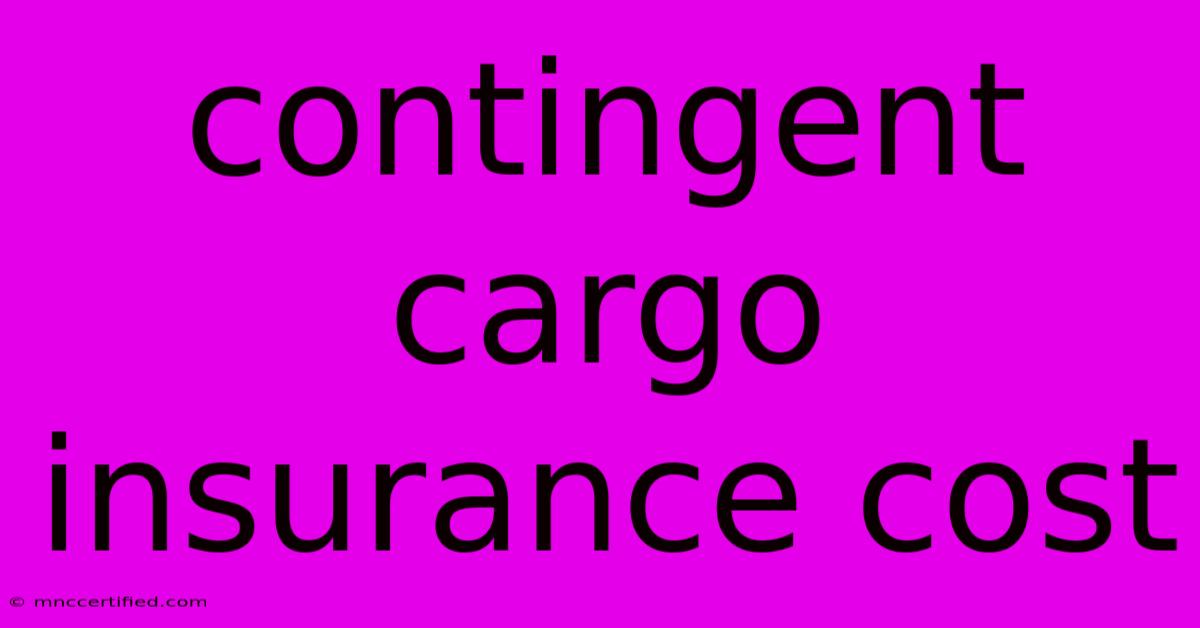Contingent Cargo Insurance Cost

Table of Contents
Contingent Cargo Insurance Cost: A Comprehensive Guide
Shipping goods internationally involves inherent risks. While standard cargo insurance covers loss or damage to goods during transit, contingent cargo insurance offers broader protection against a wider range of unforeseen circumstances. Understanding the cost of this crucial coverage is vital for businesses involved in global trade. This comprehensive guide breaks down the factors influencing contingent cargo insurance costs and helps you determine the right level of protection for your shipments.
What is Contingent Cargo Insurance?
Contingent cargo insurance goes beyond the standard protection offered by Institute Cargo Clauses (ICC) A, B, or C. It covers losses that aren't directly related to physical damage or loss of the goods themselves. These "contingent" losses can include:
- Liability to third parties: Damage caused by your cargo to other goods or property during transit.
- General average contributions: Your share of losses incurred to save a vessel and its cargo in an emergency.
- Freight and other charges: Costs incurred due to delays or damage preventing the timely delivery of goods.
- Increased costs of repair or replacement: Expenses incurred due to damage that require more extensive repairs than initially anticipated.
- Sue and labour costs: Expenses incurred in taking measures to protect the cargo from further loss or damage.
Factors Affecting Contingent Cargo Insurance Cost
The cost of contingent cargo insurance is not a fixed amount. Several factors influence the premium you'll pay:
1. Type of Coverage:
The extent of coverage directly impacts the cost. Broader coverage encompassing a wider range of contingent risks will naturally command a higher premium. A policy covering only liability to third parties will be cheaper than one covering general average, freight, and other contingent losses.
2. Inherent Risk of the Goods:
The nature of your cargo plays a significant role. Perishable goods, hazardous materials, and high-value items carry higher inherent risks and consequently higher insurance premiums. Fragile goods are also more expensive to insure due to the increased potential for damage and subsequent contingent losses.
3. Mode of Transportation:
The chosen mode of transport – sea, air, rail, or road – significantly impacts the risk profile. Ocean freight, for instance, is generally associated with higher risks than air freight due to the longer transit times and exposure to various environmental factors. This difference translates into varying insurance costs.
4. Destination and Origin:
Certain geographical areas are considered higher risk due to political instability, natural disasters, or theft. Shipping to or from these regions will result in higher insurance premiums. Similarly, transit through high-risk areas increases costs.
5. Value of the Goods:
The higher the value of the goods being shipped, the higher the insurance premium. This is a straightforward correlation: a more expensive shipment represents a larger potential loss, hence the increased cost of coverage.
6. Insurer's Risk Assessment:
Insurance companies conduct thorough risk assessments before quoting premiums. Your company's history of claims, the packaging quality of your goods, and the security measures taken during transit all contribute to the insurer's assessment of your risk profile. A cleaner claim history can significantly reduce your premiums.
7. Deductible:
Choosing a higher deductible reduces your premium. A deductible represents the amount you agree to pay in case of a claim before the insurance policy kicks in. This is a common way to manage the overall cost of contingent cargo insurance.
How to Minimize Contingent Cargo Insurance Costs
While complete avoidance of contingent cargo insurance isn’t advisable, you can take steps to minimize its cost:
- Proper Packaging and Handling: Invest in high-quality packaging to minimize the risk of damage and subsequent contingent losses. Careful handling throughout the supply chain also reduces the likelihood of claims.
- Secure Transportation: Selecting reputable carriers with proven safety records and robust security protocols can help reduce the risk profile and potentially lower your premium.
- Detailed Documentation: Maintaining accurate records of your shipments, including proper documentation, invoices, and proof of delivery, streamlines the claims process.
- Regular Risk Assessment: Regularly review your supply chain and identify potential risks. Addressing these proactively can reduce the need for extensive contingent insurance.
- Shop Around: Compare quotes from multiple insurance providers to find the most competitive premiums while ensuring adequate coverage for your specific needs.
Conclusion
Contingent cargo insurance is a crucial component of effective risk management in international trade. While the cost varies depending on numerous factors, understanding these elements enables businesses to make informed decisions, secure appropriate coverage, and effectively manage their overall shipping expenses. By implementing preventive measures and actively managing risks, businesses can optimize their contingent cargo insurance costs without compromising the crucial protection it offers.

Thank you for visiting our website wich cover about Contingent Cargo Insurance Cost. We hope the information provided has been useful to you. Feel free to contact us if you have any questions or need further assistance. See you next time and dont miss to bookmark.
Featured Posts
-
December Real Madrid Vs Messi
Nov 24, 2024
-
Colorado Vs Kansas Game Time And Channel
Nov 24, 2024
-
Oil And Gas Insurance Companies
Nov 24, 2024
-
Lehigh Valley Insurance Brokers
Nov 24, 2024
-
Arsenal 3 0 Forest Match Analysis Nov 23
Nov 24, 2024